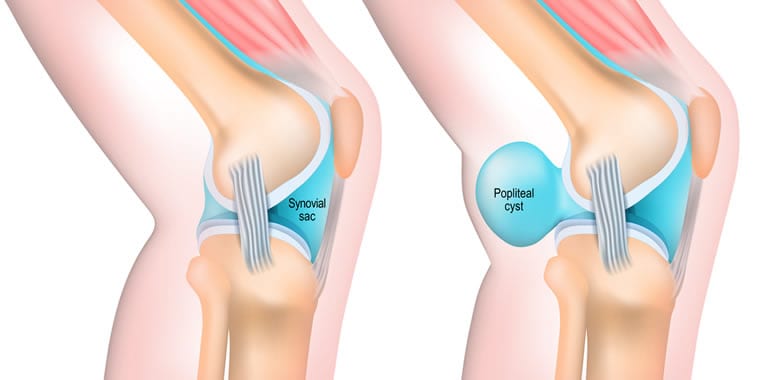
So you just received your ultrasound and/or MRI results and have been told by your doctor that you have a baker’s cyst. I am certain that has left you with more questions than answers so I want to help by answering some of those questions for you.
First off a Baker's cyst is NOT THE TYPE OF CYST YOU’RE THINKING OF. What I mean by that is a Baker’s cyst is in response to swelling in your knee. There is a pocket behind your knee and if there is excess swelling, it will pool in that area and if left long enough it will “grow” into a Baker's cyst. Essentially, think of a Baker's cyst as nothing more than an area where fluid can be held and it creates something that looks like or represents a cyst.
A Baker’s Cyst is not a diagnosis.
I understand it is given to you by doctors as a diagnosis, but the Baker’s cyst is there in response to some sort of damage or injury to your knee. Now, although you likely have heard from doctors that they can’t see anything else but the Baker’s cyst, there is more to the story..
Every patient I see that has a Baker's cyst has some sort of knee issue or mechanical issue. For example, Bob (not his real name) came in to see me and told me he had been diagnosed with a large Baker's cyst behind his knee. I asked him some questions to find out if anything could have irritated his knee recently such as if he had tried any new exercises or hobbies, did he recently have a big move that required a lot of physical movement, did he start running, etc. l Typically something has changed in terms of movement habits and routines that sparks the forming of a Baker’s cyst.
His issue was he started doing rucking (i.e., adding a 35 pound weighted vest to his hikes). Now I know you may be sitting there saying “I have done nothing different” but wait, let me get on a call with you and “interrogate” you--you will be surprised at what I can find with a little bit of digging.
Once we found a potential reason for the forming of his Baker's cyst, we went to examine his knee. What we found (which is what we find 95% of the time in patients with Baker’s cysts in their knees) was a mechanical issue. His quad muscles were far too tight, his hip muscles were too weak, and all of this led to unequal tension in his knee causing pulling in a different direction on his knee cap (it should just pull up and down for the most part). After I saw that his knee was out of whack I explained to him what was happening. Bob your knee cap is being pulled up and outwards because of how tight your quad muscles and IT band are pulling.
They are pulling so much not just because they are tight but also because your hip muscles (which are supposed to keep your leg straight) are weak and allowing your hip to collapse which puts more pressure on your knee from the outside. Now you have all of this upward and outward pulling on your knee cap. When this happens it starts to press down on the bone below it (your femur) because it is sitting higher then it is supposed to.
There is a groove where your knee cap is supposed to sit and if it sits to high then it will create pressure and friction in your knee. This pressure and friction will then cause your body to create swelling (just like a blister behind your heel when you wear new shoes). Over time this constant low grade friction based swelling will build and build and build, to the point where your body can no longer clear it from your knee joint. So then what happens? It starts to pool in the pocket behind your knee, when left long enough VOILA you have a Bakers Cyst.
Now this issue I just explained does not always create pain in your knee, which is why you were able to get to this point of having a large bakers cyst because you didnt know it was happening. So dont be mad or blame oyurself but know that we can fix this issue.
What we do is strengthen the hip muscles, loosen the quad muscles and clear the fluid from your knee and you will be as good as new. Of Course I put it very simply and there is more to it then that (from my end) but in the most basic terms this is 95% of what I see when someone comes in with a Bakers cyst and is most likely going on in your knee.
If you are skeptical and would like to get on a call with me right now to discuss how I can fix you bakers cyst just call 647 799 0966. If you prefer to you can email me directly at nick@physioforsurgery.ca and headline the title Baker's Cyst.


